Timber or Concrete: Which Stump to Use for Your Home?
Which is better? Timber stumps or concrete stumps? This question comes up every time someone is looking to restump a house, and it isn’t one that can be answered easily. This is because there is no clear cut, black and white answer. There are many different variables that contribute to how either concrete or timber stumps perform, so let us take a look at those and go from there.
Why Stumps Sink
The main issue that comes into play with houses that sit on stumps is that the stumps will sink, which affects the distribution of the houses weight, which, in turn, leads to the house not balancing properly on its foundations. The fact is that both types of stumps will sink, but for different reasons, so it is important to look at the soil quality around the area as well as the rest of the foundations and how they have been built. Some locations will benefit from using a different type of stump, so there is no definitive answer except to assess the situation on a case by case basis.
Termites and Dry Rot
When it comes to wooden stumps, your worst enemy is going to be termites and other borers. As they bore, they push the dirt up into the middle of the stump, which affects the distribution of the weight. This, in turn, causes issues with the structural integrity of the foundations being able to hold the house in place and it may start to sink in some places, causing a lot of damage along the way. Dry rot is another issue that is common with wooden stumps, with overexposure to moisture causing irreparable damage. Most of the timber we use in stumps nowadays is treated with CCA (Copper Chrome Arsenic), which usually helps with these problems, but the stumps need to be replaced every ten years or so.
Soil Quality
One thing that will also affect wooden stumps is the quality of the soil in which they are being placed, and whether the structure has been adequately fortified. Some areas that have black soil will be prone to sinking so this needs to be taken into account during the planning and preparation stages to ensure that all necessary precautions have been taken.
Cracking and Reinforcement
With cement stumps, your main issue is going to be with cracking. In the past we needed to use old crushed concrete for making the stumps but these days, we are able to use other recycled materials, which allows us to produce stronger quality concrete stumps. If you are using concrete stumps, it is important to ensure that the steel reinforcing rods are not rusted, otherwise this can cause problems as well by putting too much pressure on the stumps.
The best way to ensure that you get the right stumps that tick all the boxes for you, is to talk to an expert and get the best advice you can – give us a call today at Black and White House Raising and Restumping.



